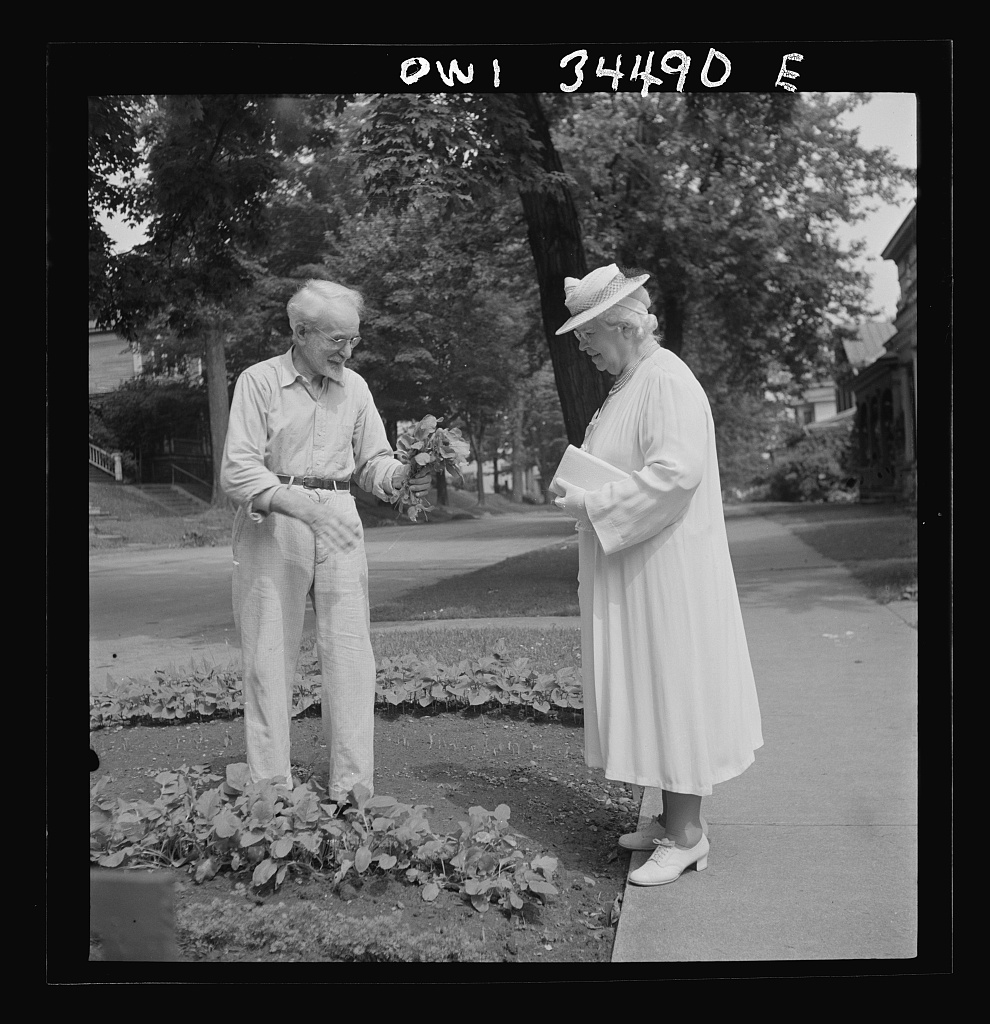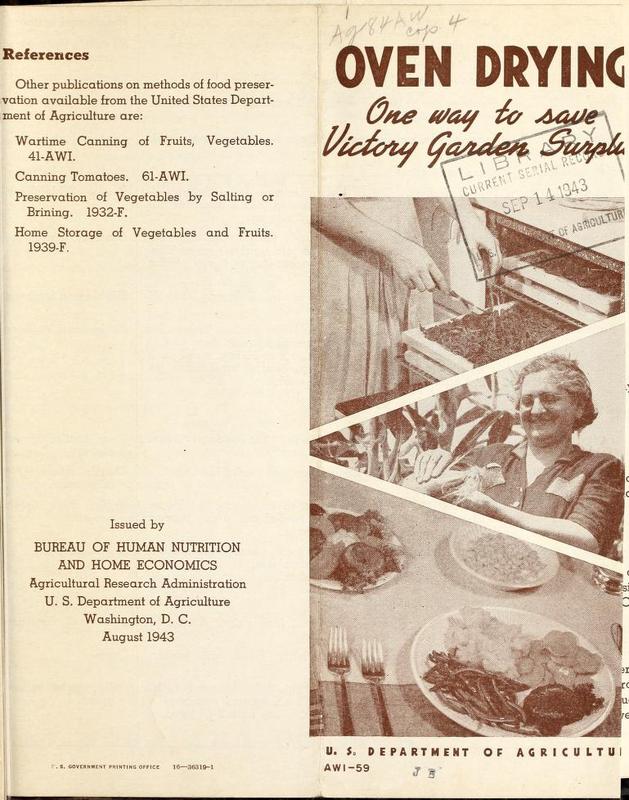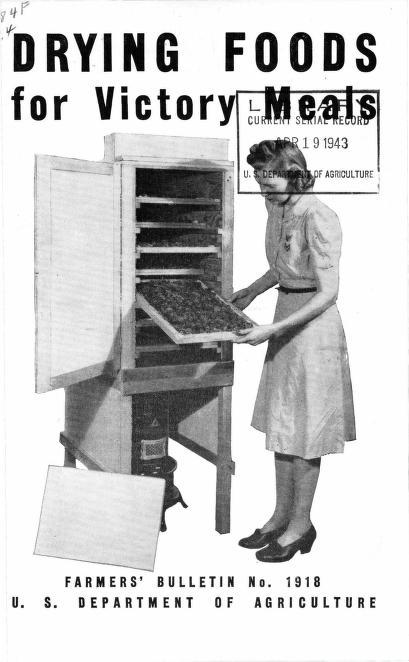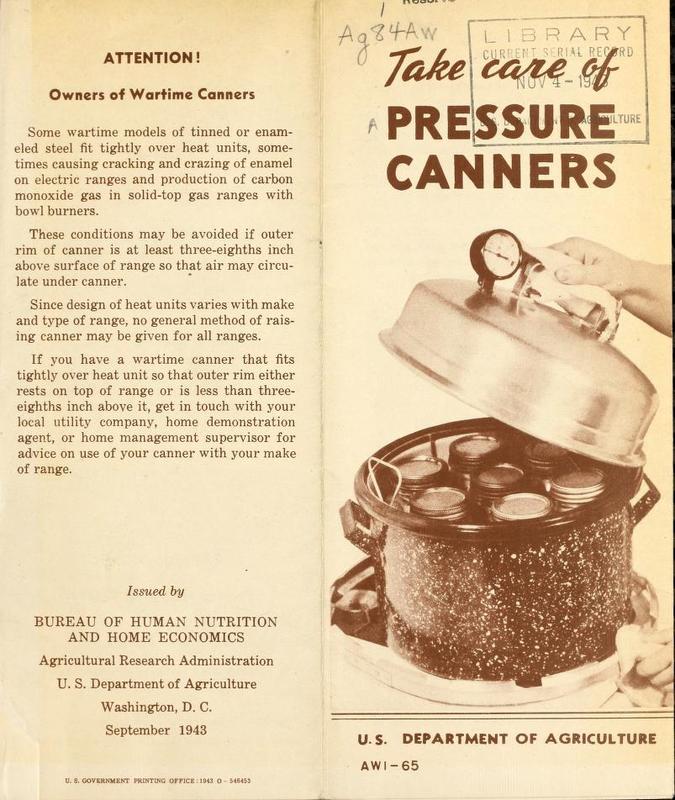Preserving the Products of the Victory Garden

Oswego, New York. A citizen showing his wife vegetables from his victory garden as she starts on her way to church, (1943). Marjory Collins, Photographer. Library of Congress, Prints and Photographs Division. LC-DIG-fsa-8d31668.
The following reports published by the U.S. Department of Agriculture describe various methods for preserving the food produced by the Victory Garden.
Oven Drying: One Way to Save Victory Garden Surplus (1943).
Bureau of Human Nutrition and Home Economics. U.S. Department of Agriculture. AWI: Number 59.
"If you have a gas or electric range in the kitchen - The oven offers a simple and satisfactory way to dry fruits and vegetables for winter meals.
Apples to Turnips
Most foods successfully dried in the sun or in a home drier can be dried in an oven.
The drying table in this folder gives directions for 39 fruits and vegetables — from apples to turnips. If there's a star on the list, it's dried sweet corn because of its good flavor and because corn is the hardest vegetable to can successfully at home.
Home drying doesn't suit lettuce, melons, cucumbers, radishes. Asparagus can be dried, but is not so good as most dried vegetables.
Understand at the Start
1. Oven drying is small-scale drying. An oven can take 4 to 8 pounds — preferably 6 — of a prepared fruit or vegetable at one drying load. It takes most of a day for the load to dry.
2. Oven drying is a watchman's job. Never go off and leave food drying in an oven. Gas pressure may change. If trays should catch fire, turn off the heat and close the oven door."
Drying Foods for Victory Meals (1942).
Bureau of Human Nutrition and Home Economics. U.S. Department of Agriculture. Farmers' Bulletin: Number 1918.
"VICTORY GARDENS lead directly to victory meals — all the year round — for those who take thought for the morrow and put by a store of fruits and vegetables.
Part of the food from orchard and garden will be canned or pickled, or made into preserves, jam, or jelly. Some foods will go into freezer lockers. Some — such as potatoes, turnips, carrots, parsnips, and late- maturing cabbage — can readily be stored in cellars or outdoor pits and should be taken care of in this way rather than by drying. Other foods, too perishable for storing, will need to be dried at home with simple equipment.
IMPORTANT IN WARTIME
Home drying is especially important in wartime because it does not require sugar — nor the metals, rubber, and other materials used in more common types of food preservation. Drying is not a difficult job. However, it does take time — and constant attention — especially at the beginning and the end of the process."
Be A Victory Planner in Your Home (1942).
Bureau of Human Nutrition and Home Economics. U.S. Department of Agriculture. Farmers' Bulletin: Number 1918.
"Plan to do your part at home
1. Spend less and save more
2. Make things and have more
3. Cut waste and make things last
4. Buy carefully and stretch pennies
5. Budget your hours and make each count
6. Safeguard your family and help guard your country"
Community Food Preservation Centers (1941).
Furman, Bess. Bureau of Human Nutrition and Home Economics. U.S. Department of Agriculture. Miscellaneous Publication: Number 472.
"Community food preservation centers now in operation range all the way from homes with a base of neighborhood operations in the back yard to former commercial canning and refrigerator plants that have been taken over by the community. They include use of church and community kitchens and home economics laboratories, converted store buildings, laundries, and creameries. In one State so many communities have built their own plants that the State agricultural college sends out a pamphlet of building plans, based on practical experience. Equipment ranges from home-size pressure cookers and vats made by the local blacksmith to hotel- and factory-size retorts [sic] with an investment of thousands of dollars. Some centers serve individual families; some, the schools and institutions of a county; some, large sections of low-income population. Products are varied by geography; processes by food habits. Out of this great variety some helpful generalizations may be drawn."
Home Canning of Fruits and Vegetables : Seven Points for Success (1944).
Bureau of Human Nutrition and Home Economics. U.S. Department of Agriculture. AWI: Number 93.
"In the air, water, and soil at all times, there are tiny organisms — molds, yeasts, and bacteria — that cause fresh food to spoil.
When you can fruits and vegetables, you heat them hot enough and long enough to make these organisms harmless, so the food will keep. Heating in a canner is called processing.
For fruits, tomatoes, pickled vegetables — use a boiling-water bath. You can process these acid foods safely in boiling water.
For corn, peas, beans, and other common vegetables (except tomatoes) — use a steam pressure canner. To process these foods safely in reasonable time takes a temperature higher than boiling. It takes 240° F. or higher. The only way to get these high temperatures is to hold steam under pressure.
New pressure canners are being manufactured all the time. They are no longer rationed.
If you have no pressure canner, team with someone who has. Or maybe you can go to a community canning center."
Take Care of Pressure Canners (1943).
Bureau of Human Nutrition and Home Economics. U.S. Department of Agriculture. AWI: Number 65.
"ATTENTION! Owners of Wartime Canners
Some wartime models of tinned or enameled steel fit tightly over heat units, sometimes causing cracking and crazing of enamel on electric ranges and production of carbon monoxide gas in solid-top gas ranges with bowl burners.
These conditions may be avoided if outer rim of canner is at least three-eighths inch above surface of range so that air may circulate under canner.
Since design of heat units varies with make and type of range, no general method of raising canner may be given for all ranges.
If you have a wartime canner that fits tightly over heat unit so that outer rim either rests on top of range or is less than three-eighths inch above it, get in touch with your local utility company, home demonstration agent, or home management supervisor for advice on use of your canner with your make of range."
Home Canning of Fruits, Vegetables, and Meats (1942).
Stanley, Louise, Stienbarger, Mabel C.. and Shank, Dorothy Esther. Bureau of Human Nutrition and Home Economics. U.S. Department of Agriculture. Farmers' Bulletin: Number 1762.
"CANNING is a method of using heat and airtight containers to preserve food as nearly as possible in the condition in which it is served when freshly cooked. It is a desirable and economical method of preserving many foods so that their use can be distributed over seasons and to places where they are not available fresh. Canned foods thus make possible a better-balanced and more-varied diet throughout the year.
The method of canning foods affects the vitamin content to some extent. With the possible exception of vitamin C there may be no serious loss during the canning process, though of course when foods are removed from the cans and reheated before serving, there may be additional loss of vitamins. In order to preserve all the vitamins possible in canned products, emphasis is placed throughout this bulletin on canning foods very soon after they are gathered and on carrying every step of the process through rapidly. Precooking foods for a short time, packing them hot, and processing them in the containers help to preserve the vitamin value.
None of the minerals in foods need be lost in canning, providing the liquid in which they are precooked is used to fill up the containers and provided the entire contents of the can is served.
A canning budget prepared at the beginning of the season will indicate what quantities of different canned foods are needed by the family. In making such a budget, consider the number of persons in the family, the length of time that fresh foods are out of season, and what foods are available for canning, as well as the cost of equipment and containers, and the value of the time of the persons doing the work. Assistance in planning a canning budget suitable to the locality and adapted to the nutritional requirements of the family may be obtained from the State college of agriculture."
 An official website of the United States government.
An official website of the United States government.








